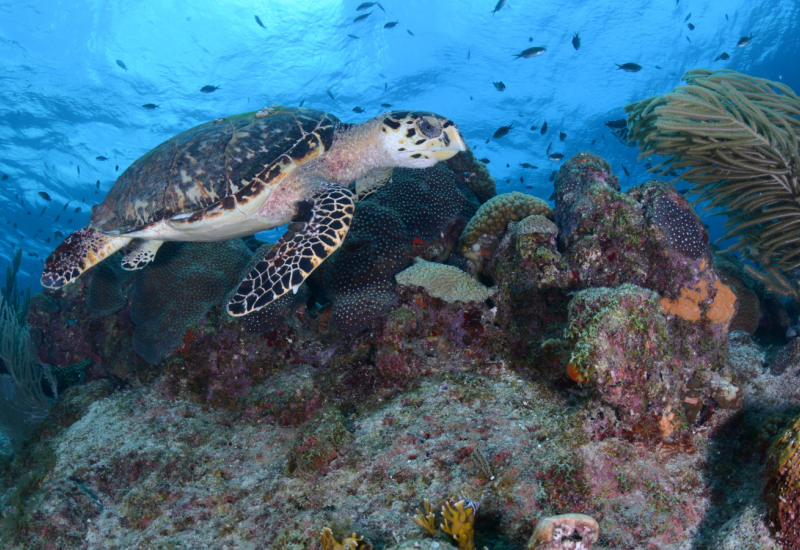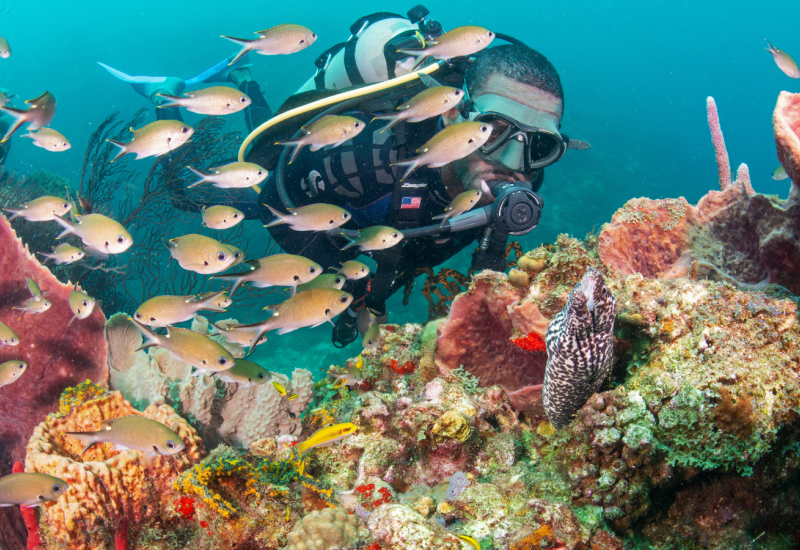Exploring Japanese WWII Wrecks in Truk Lagoon, Micronesia

Shinkoku Maru wreck
Chris Jackson
It’s our last day on the Odyssey and the dive deck is charged. A few passengers pull out satellite phones to make calls home, and there are jokes among the group about wills being in order. The entire week has led up this dive on the San Francisco Maru, the so-called Million Dollar Wreck. Felled by six 500-pound bombs during the U.S. Navy’s Operation Hailstone in 1944, the World War II cargo ship burned furiously before sinking stern first to an eventual upright position in 210 feet of water. The Japanese brought the 385-foot-long ship to Truk Lagoon, Micronesia, in anticipation of a battle with amphibious landings by American troops, and it was fully loaded with ordnance when it sunk. The deck starts at 165 feet. It will be my deepest dive yet, and my single aluminum 80-cubic-inch cylinder will grant me only about 15 minutes of bottom time.
I giant-stride off the back of the Odys__sey and follow my guide down through the opaque blue-green water that’s had a habit of revealing its secrets slowly throughout the week, like a veil lifting.
“I think diving in Truk Lagoon is really at its best right now,” the Odyssey’s captain, J.J. Skowronski, told me earlier, “The wrecks are still intact enough to allow ample penetration, and the prolific soft-coral growth is the best it’s ever been and probably ever will be.”
Throughout the week, we’ve heard creaking on some of the other wrecks, and have even seen puffs of silt erupt from areas that have recently caved in. It’s easy to surmise they won’t be here forever.
My depth gauge registers 100 feet before the San Francisco’s deck finally comes into view. It’s a world of its own — a time capsule that somehow makes me feel like I’m the first diver ever to see it. Three armored Mitsubishi tanks, stored as deck cargo, rest forward of the super-structure. One was tossed atop the other, either by the force of the ship hitting the ocean floor or by some post-sinking bomb reverberations. Mushroomlike corals grow on the tires of one of the tanks, looking remarkably like treading. I peer into an open hatch and imagine the confined quarters three Japanese soldiers would have shared.
My bottom time disappears like silt into the water, and it’s time to ascend. For this wreck alone I know I’ll make the long trek back to Truk Lagoon some day.
How to Dive Truk Lagoon from the Odyssey
“Diiiiive briefing” — the bellow two or three times a day on board the Odyssey. And if there’s any place a diver should pay attention, it’s here. “We like to let people dive the way they’d like to dive if they were able to,” explains Capt. Skowronski. “Most people are used to being led by the nose around a dive site. But here, as long as they’re qualified and comfortable in the water, they can dive the way they want to dive.”
Feel like penetrating the depths of an engine room, then lingering in deep cargo holds, and extending your bottom time with twin tanks, a sling of 100 percent oxygen and extended deco? No problem. And if you’re more of a single aluminum 80 type of diver and would like a guide to help you discover the more interesting areas among Truk Lagoon’s more than 60 wrecks, that’s in the cards (and included in the price) too.
I opt for the latter, joining Kent — an Odyssey guide who’s been nicknamed “The Legend” — to explore the 329-foot- long Heian Maru one afternoon. Raised in Chuuk on these wrecks, Kent has more than 10,000 dives in the lagoon, perhaps more than anybody, and he navigates the darkest recesses as if by osmosis. I follow him through hold No. 5 into an inky-black interior — making a few switchbacks I’d hardly dare on my own — to ogle a medicine chest loaded with glass bottles and instruments. Then we wind through the crew quarters to an area where china had been stored and now lies in eerie piles that look like they just cascaded to the floor. Kent checks to make sure I’m cool with continuing (I am), and we use our remaining bottom time to ogle enormous torpedoes in hold No. 2 and periscopes stowed on the ship’s starboard side.
Diving from the Odyssey is a leisurely affair, as most of the wrecks are within a short sail of each other inside the lagoon. The fact that most mooring balls are right over the wrecks means you can get in the water at your own pace and divide your day’s dives based on where you want to spend the most bottom time (you’ll visit two wrecks most days, sometimes three, and night dives are offered too). The itinerary takes in deeper wrecks as the week progresses to prep divers for the deepest attraction, the San Francisco Maru.
Back on the 439-foot long wreck of the Yamagiri Maru, the scene takes a macabre turn as I follow my guide through several chambers into a small room shrouded with curtains of rusting metal. Twelve crew members died on the ship during Operation Hailstone. My guide’s light fixes on a human skull fused to a bulkhead, and it takes me a while to recognize the telltale eye sockets in the rust-colored surrounds. It’s the skull of the ship’s engineer. He’d been attempting to fix the generator when the ship was attacked, and the force of multiple bombs fused his skull to the metal. His bones are piled a few feet below, and farther down his fingers are frozen in a grasp on another piece of metal.
Hanging from the Odyssey’s safety bar at the end of the dive, I spot a school of silvery minnows flitting about in the sparkling Micronesian sun. As the minutes of my safety stop tick away, I imagine them as reincarnated sailors’ souls.
Need to Know
» When to Go Diving conditions and visibility are fairly consistent in Truk Lagoon. The trade winds are from the northeast from December to April, and seas are at their calmest. Weather in August and September is less consistent.
» Dive Conditions Water temperature is 86 degrees year-round. A Lycra skin suits most divers, but if you’re prone to get cold after multiple dives, bring your shorty or 3 mm wetsuit.
» Operator With nine spacious cabins (including two singles), all with private bathrooms, the Odyssey is the finest live-aboard in Truk Lagoon. The ship moors within a short swim of each wreck, so you can get ready on the roomy dive deck (with personal storage areas and a camera table), then giant-stride right off the back. All meals are served buffet-style (American-style comfort food and frequent barbecues), with snacks offered after every dive. An open bar is included.
» Price Tag Seven-night cruises run Sunday to Sunday (with an average of four dives per day) and cost US $3,095 per person, based on double occupancy. Nitrox is free, and special oxygen mixes (including 100 percent) are also available at an additional cost. Rental gear is limited and should be reserved in advance.

Chris JacksonShinkoku Maru wreck
It’s our last day on the Odyssey and the dive deck is charged. A few passengers pull out satellite phones to make calls home, and there are jokes among the group about wills being in order. The entire week has led up this dive on the San Francisco Maru, the so-called Million Dollar Wreck. Felled by six 500-pound bombs during the U.S. Navy’s Operation Hailstone in 1944, the World War II cargo ship burned furiously before sinking stern first to an eventual upright position in 210 feet of water. The Japanese brought the 385-foot-long ship to Truk Lagoon, Micronesia, in anticipation of a battle with amphibious landings by American troops, and it was fully loaded with ordnance when it sunk. The deck starts at 165 feet. It will be my deepest dive yet, and my single aluminum 80-cubic-inch cylinder will grant me only about 15 minutes of bottom time.
I giant-stride off the back of the Odyssey and follow my guide down through the opaque blue-green water that’s had a habit of revealing its secrets slowly throughout the week, like a veil lifting.
“I think diving in Truk Lagoon is really at its best right now,” the Odyssey’s captain, J.J. Skowronski, told me earlier, “The wrecks are still intact enough to allow ample penetration, and the prolific soft-coral growth is the best it’s ever been and probably ever will be.”
Throughout the week, we’ve heard creaking on some of the other wrecks, and have even seen puffs of silt erupt from areas that have recently caved in. It’s easy to surmise they won’t be here forever.
My depth gauge registers 100 feet before the San Francisco’s deck finally comes into view. It’s a world of its own — a time capsule that somehow makes me feel like I’m the first diver ever to see it. Three armored Mitsubishi tanks, stored as deck cargo, rest forward of the super-structure. One was tossed atop the other, either by the force of the ship hitting the ocean floor or by some post-sinking bomb reverberations. Mushroomlike corals grow on the tires of one of the tanks, looking remarkably like treading. I peer into an open hatch and imagine the confined quarters three Japanese soldiers would have shared.
My bottom time disappears like silt into the water, and it’s time to ascend. For this wreck alone I know I’ll make the long trek back to Truk Lagoon some day.
How to Dive Truk Lagoon from the Odyssey
“Diiiiive briefing” — the bellow two or three times a day on board the Odyssey. And if there’s any place a diver should pay attention, it’s here. “We like to let people dive the way they’d like to dive if they were able to,” explains Capt. Skowronski. “Most people are used to being led by the nose around a dive site. But here, as long as they’re qualified and comfortable in the water, they can dive the way they want to dive.”
Feel like penetrating the depths of an engine room, then lingering in deep cargo holds, and extending your bottom time with twin tanks, a sling of 100 percent oxygen and extended deco? No problem. And if you’re more of a single aluminum 80 type of diver and would like a guide to help you discover the more interesting areas among Truk Lagoon’s more than 60 wrecks, that’s in the cards (and included in the price) too.
I opt for the latter, joining Kent — an Odyssey guide who’s been nicknamed “The Legend” — to explore the 329-foot- long Heian Maru one afternoon. Raised in Chuuk on these wrecks, Kent has more than 10,000 dives in the lagoon, perhaps more than anybody, and he navigates the darkest recesses as if by osmosis. I follow him through hold No. 5 into an inky-black interior — making a few switchbacks I’d hardly dare on my own — to ogle a medicine chest loaded with glass bottles and instruments. Then we wind through the crew quarters to an area where china had been stored and now lies in eerie piles that look like they just cascaded to the floor. Kent checks to make sure I’m cool with continuing (I am), and we use our remaining bottom time to ogle enormous torpedoes in hold No. 2 and periscopes stowed on the ship’s starboard side.
Diving from the Odyssey is a leisurely affair, as most of the wrecks are within a short sail of each other inside the lagoon. The fact that most mooring balls are right over the wrecks means you can get in the water at your own pace and divide your day’s dives based on where you want to spend the most bottom time (you’ll visit two wrecks most days, sometimes three, and night dives are offered too). The itinerary takes in deeper wrecks as the week progresses to prep divers for the deepest attraction, the San Francisco Maru.
Back on the 439-foot long wreck of the* Yamagiri Maru, the scene takes a macabre turn as I follow my guide through several chambers into a small room shrouded with curtains of rusting metal. Twelve crew members died on the ship during Operation Hailstone. My guide’s light fixes on a human skull fused to a bulkhead, and it takes me a while to recognize the telltale eye sockets in the rust-colored surrounds. It’s the skull of the ship’s engineer. He’d been attempting to fix the generator when the ship was attacked, and the force of multiple bombs fused his skull to the metal. His bones are piled a few feet below, and farther down his fingers are frozen in a grasp on another piece of metal.
Hanging from the Odyssey’s safety bar at the end of the dive, I spot a school of silvery minnows flitting about in the sparkling Micronesian sun. As the minutes of my safety stop tick away, I imagine them as reincarnated sailors’ souls.
Need to Know
» When to Go Diving conditions and visibility are fairly consistent in Truk Lagoon. The trade winds are from the northeast from December to April, and seas are at their calmest. Weather in August and September is less consistent.
» Dive Condition Water temperature is 86 degrees year-round. A Lycra skin suits most divers, but if you’re prone to get cold after multiple dives, bring your shorty or 3 mm wetsuit.
» Operator With nine spacious cabins (including two singles), all with private bathrooms, the Odyssey is the finest live-aboard in Truk Lagoon. The ship moors within a short swim of each wreck, so you can get ready on the roomy dive deck (with personal storage areas and a camera table), then giant-stride right off the back. All meals are served buffet-style (American-style comfort food and frequent barbecues), with snacks offered after every dive. An open bar is included.
» Price Tag Seven-night cruises run Sunday to Sunday (with an average of four dives per day) and cost US $3,095 per person, based on double occupancy. Nitrox is free, and special oxygen mixes (including 100 percent) are also available at an additional cost. Rental gear is limited and should be reserved in advance.










